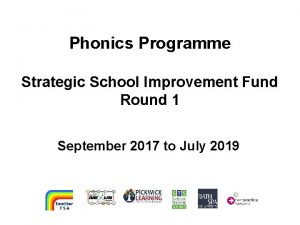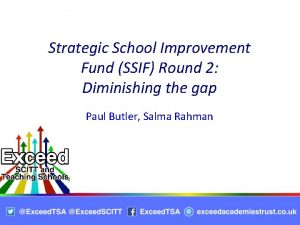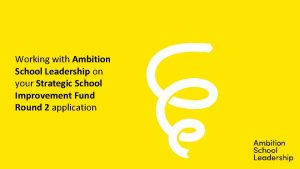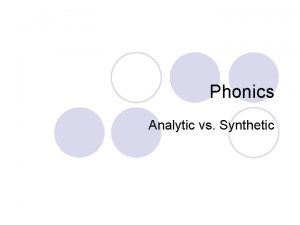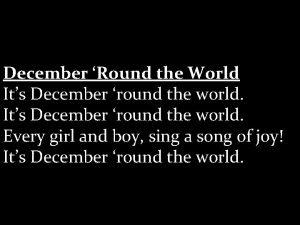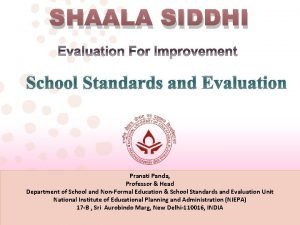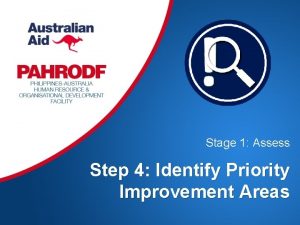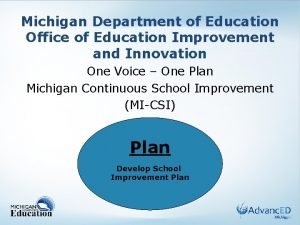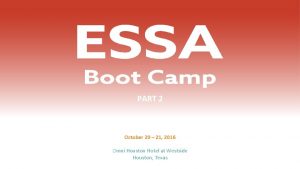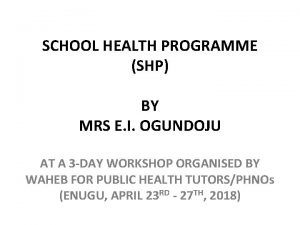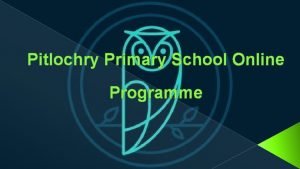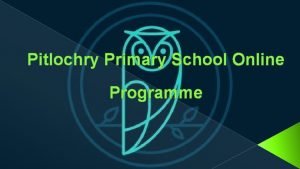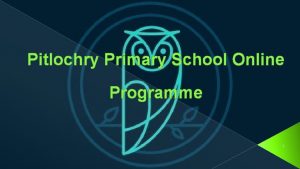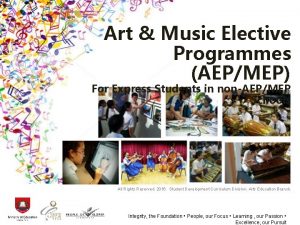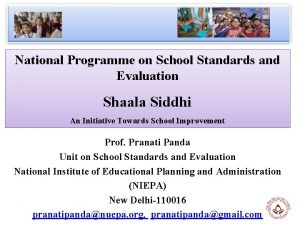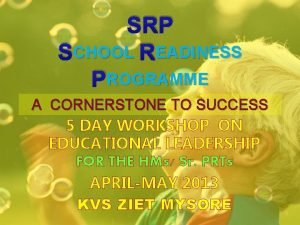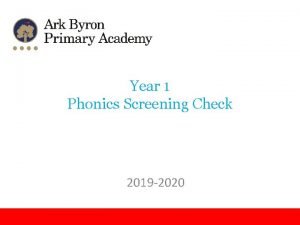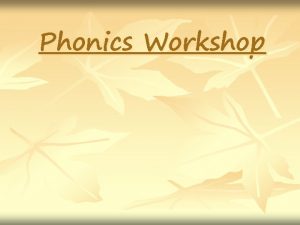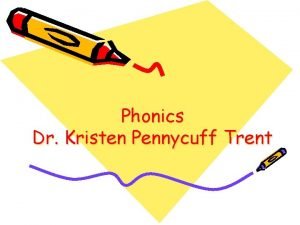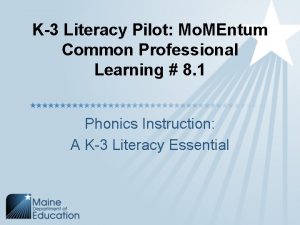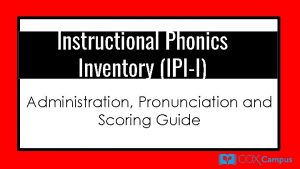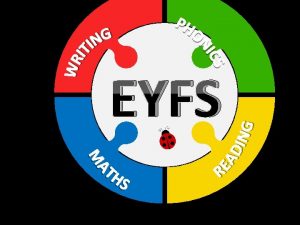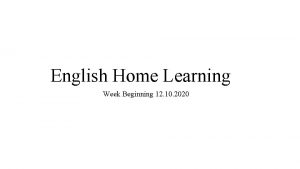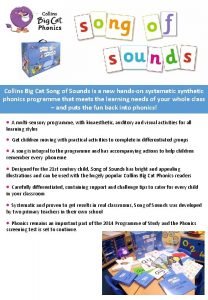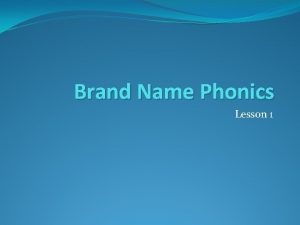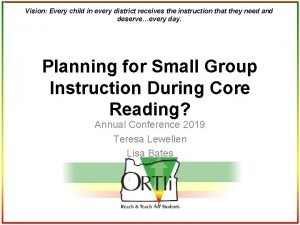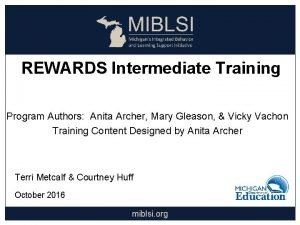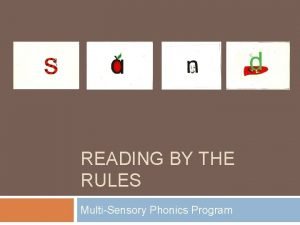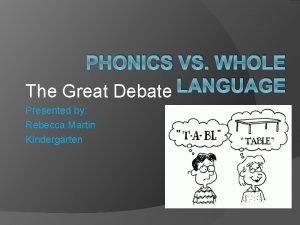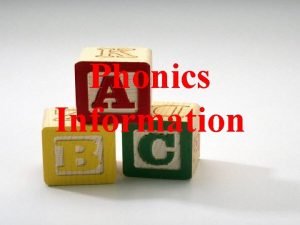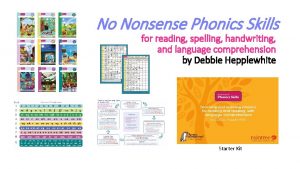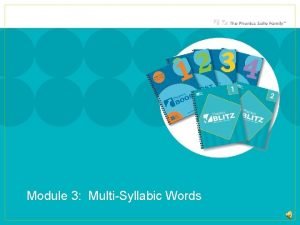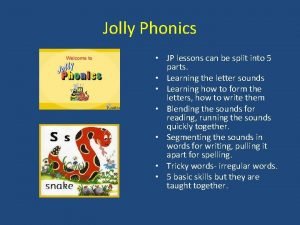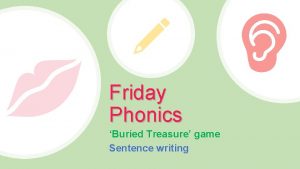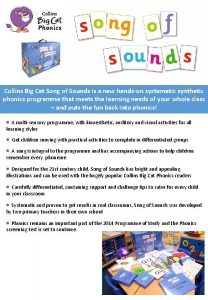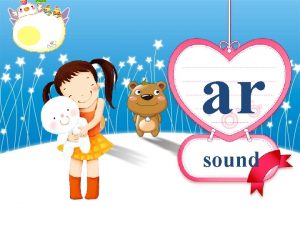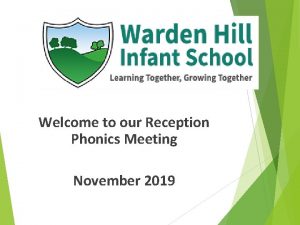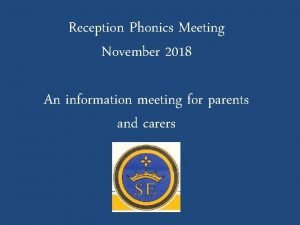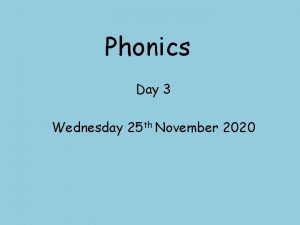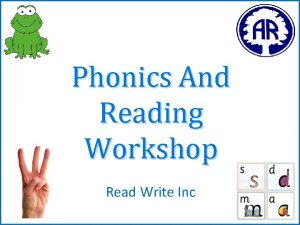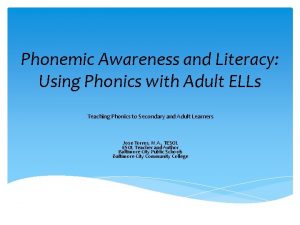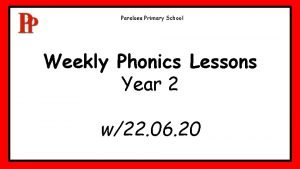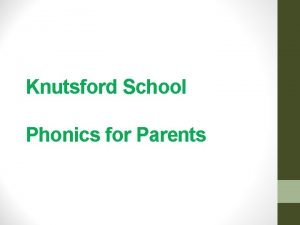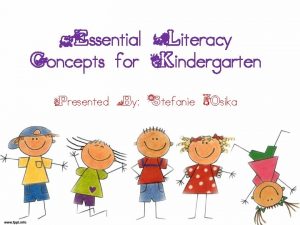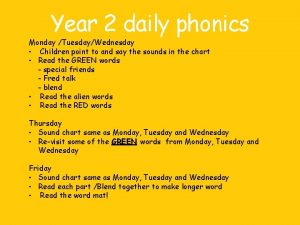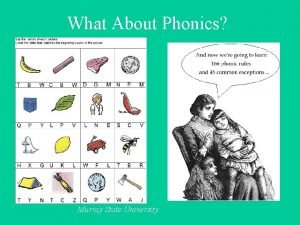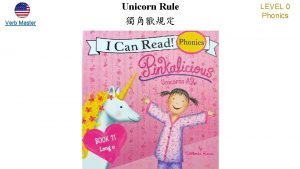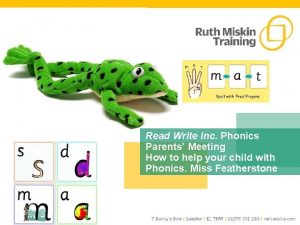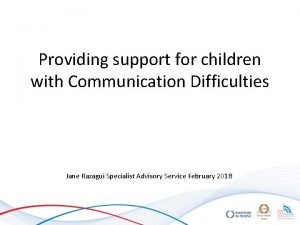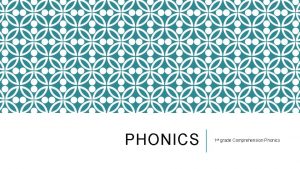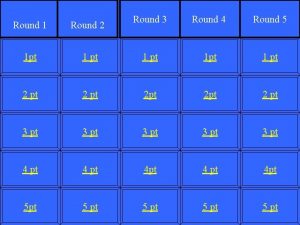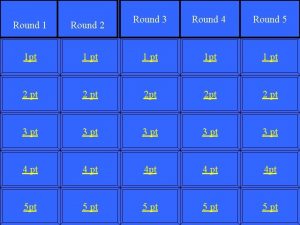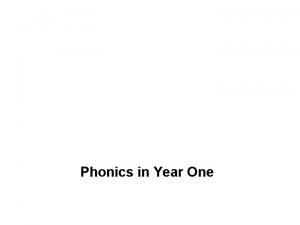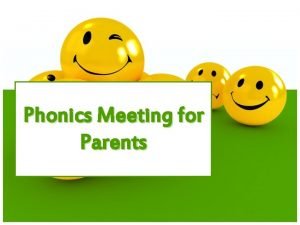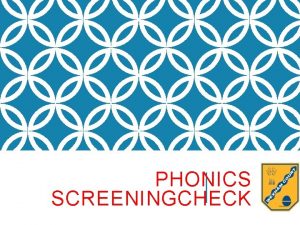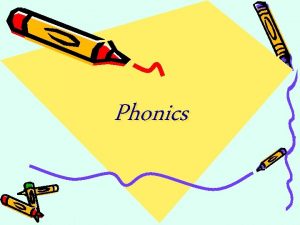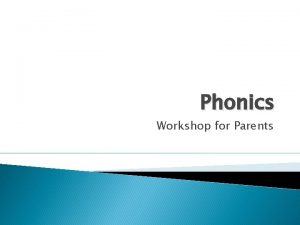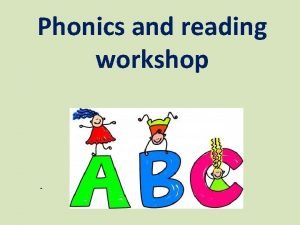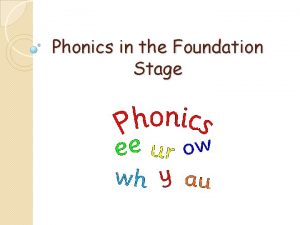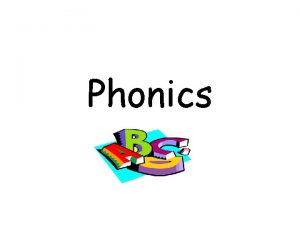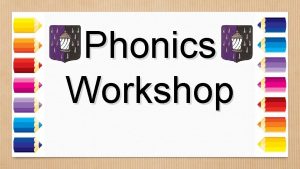Phonics Programme Strategic School Improvement Fund Round 1




![“The evidence is clear […] that direct systematic instruction in phonics during the early “The evidence is clear […] that direct systematic instruction in phonics during the early](https://slidetodoc.com/presentation_image_h2/3a8ccc0e79ba4dfb815e7fa01d328ed7/image-5.jpg)


























































- Slides: 63

Phonics Programme Strategic School Improvement Fund Round 1 September 2017 to July 2019

Welcome, introductions and overview of the Launch Jenny Violette Phonics Programme Director Sarah Frame Director Excalibur TSA

“ Phonics is a load of rubbish. I learnt to read without it. ” Direct quote from a parent.

Why Phonics? • It helps develop speech • It supports the recognition of the sounds of letters of the alphabet • It supports spelling • Supports reading fluency (reading text accurately) • Improves reading comprehension – if you can’t pronounce it you can’t understand it • Develops confidence
![The evidence is clear that direct systematic instruction in phonics during the early “The evidence is clear […] that direct systematic instruction in phonics during the early](https://slidetodoc.com/presentation_image_h2/3a8ccc0e79ba4dfb815e7fa01d328ed7/image-5.jpg)
“The evidence is clear […] that direct systematic instruction in phonics during the early years of schooling is an essential foundation for teaching children to read. […] Moreover, where there is unsystematic or no phonics instruction, children’s literacy progress is significantly impeded, inhibiting their initial and subsequent growth in reading accuracy, fluency, writing, spelling and comprehension. ” Australian national inquiry into the teaching of literacy

Reading for pleasure • Phonics builds on and develops early speaking and listening skills • It contributes to language acquisition • Children will ‘speak’ their favourite stories before reading them • When they can read with fluency they will develop a love of reading

South West Priority: Phonics (maths, EYFS, oracy, literacy, leadership, disadvantaged) Stubborn challenge: The progress and attainment of our most disadvantaged children 2016/17 National Results Y 1: Expected standard or above All pupils: 81% Non-FSM: 84% FSM: 68% Promoting phonics mastery and reducing the attainment gap in the SW


Why phonics? Breaking the code. Nicola Bloom challenge learn inspire grow bloom

What do we mean by phonics? • English operates on an alphabetic system; that is, 26 symbols (the letters of the alphabet) represent approximately 44 sounds, singly and in combination. • We can learn to recognise these symbols, singly and in combination, and assign sounds to them in order to read (grapheme-phoneme correspondence) • We can learn to segment words into sounds and identify the correct symbols in order to spell (phoneme-grapheme correspondence) challenge learn inspire grow bloom

challenge learn inspire grow bloom

challenge learn inspire grow bloom

Breaking the code We are so used to recognising words almost instantly, we don’t realise what we’re doing. So if p= /p/ a = /a/ t= /t/ what does pat say? We even call it “decoding”. challenge learn inspire grow bloom

Problems? giant, gnaw, get, thing jet, bridge you, sky, pretty rough, through. . . challenge learn inspire grow bloom

Too many sounds. . . English is not “biunique” – that is, the same grapheme can represent different phonemes, and the same phoneme can be represented by different graphemes. This makes breaking the code a bit harder One advantage – we have lots of possible spellings for neologisms, to distinguish them from existing words! bite - byte - bight challenge learn inspire grow bloom

But we seem to manage – how? In reading. . . challenge learn inspire grow bloom

And writing. . . What does this say? ghoti and why can’t it really say that? challenge learn inspire grow bloom

Why phonics? So if there are other “clues” in reading and writing, why are we focusing on phonics? Because phonics is the most reliable way of getting the words off the page to start with. And getting started is important. challenge learn inspire grow bloom

Cause and effect? • 89% of those children reaching the expected phonics standard in Y 1 reached the expected standard in reading in Y 2 • 31% were working at a greater depth within the expected standard • Of those who reached the phonics standard only in Y 2, only 36% were working at the expected standard in reading, and 2% working at greater depth. 54% were working towards the expected standard in reading. challenge learn inspire grow bloom

Why phonics? Findings from research • Systematic phonics programs significantly more effective than non-systematic or no phonics programs. • Systematic phonics programs significantly more effective when given in kindergarten or first grade • Systematic phonics programs led to better reading comprehension in younger children National Reading Panel 2000 challenge learn inspire grow bloom

Why phonics? Findings from research • “Systematic phonics instruction within a broad literacy curriculum was found to have a statistically significant positive effect on reading accuracy. “ Torgerson, Brooks and Hall, 2006 • “The use of a systematic phonics programme is supported by very extensive evidence. Seven metaanalyses, which include studies of 5 -7 year old pupils have consistently demonstrated the impact of phonics on early reading. ” Improving literacy in key stage 1 Guidance Report EEF But why? challenge learn inspire grow bloom

This is because? challenge learn inspire grow bloom

This is because. . . Studies of young readers who haven’t acquired knowledge of the alphabet show that they attend to irrelevant and unhelpful features to recall words, which will not work consistently. Other examples include the “ll” in ‘ball’ and the dot in ‘television’. Knowing grapheme-phoneme correspondences gives you consistent challenge learn inspire growabloom mnemonic.

The Simple View of Reading

printed word Lexical route letter identification Non-lexical route orthographic store grapheme‒phoneme semantic store conversion system phonological store The dualroute model phoneme units spoken word

This is because. . . • To be recognised speedily on sight, words have to be in the reader’s “mental lexicon” – you have to know the word before you can read it. • Getting a word into the mental lexicon requires a consistent mnemonic method; you can’t memorise the look of every word (and you might not have a thumbprint to help you!) challenge learn inspire grow bloom

Findings from research Learning to recognise sounds in words (phonemes) and the letters that make them helps fix orthographic knowledge in the brain. (Once you know a particular graphemephoneme correspondence you recognise it in other words; you have to pay less and less attention to it until it becomes an automatic response. ) Share, 1995 (and more recently); Stuart, 2006 a, 2006 b; Savage and Stuart, 2006; Ehri 1999 challenge learn inspire grow bloom

In other words. . . the better you get at recognising letters and letter patterns and the sounds the letters make the bigger your mental lexicon gets so you recognise more words more quickly (because the lexical and non-lexical routes are both working efficiently) the more words you know, the better you challenge learn inspire grow bloom are at reading.

The importance of early decoding success in reading The earlier children become fluent decoders, the more time and cognitive space they have to develop • reading stamina • a competent working memory • a wide vocabulary • comprehension skills and the more likely they are to read for pleasure. challenge learn inspire grow bloom

The purpose of phonics. . . is to move from /c/ /a/ /t/ to

About the phonics programme Sian Kinder – Director Nexus TSA Sarah Frame – Director Excalibur TSA

Phonics Central Hub Strategic School Improvement Fund Board Excalibur TSA Programme Director Bath Spa University Best Practice Wiltshire LA S Glouc LA Bristol LA Swindon LA N Wilts Hub Excalibur TSA 3 SLEs S Wilts Hub Pickwick Salisbury 4 SLEs W Wilts Hub Pickwick Corsham 4 SLEs Nexus Hub 5 SLEs Swindon Hub 5 SLEs 7 Schools 7 Teacher and 7 Teaching Assistant Phonics Champions 10 Schools 10 Teacher and 10 Teaching Assistant Phonics Champions 8 Schools 8 Teacher and 8 Teaching Assistant Phonics Champions 14 Schools 14 Teacher and 14 Teaching Assistant Phonics Champions

What the programme aims to achieve in the classroom • • • Improving the quality of phonics teaching and provision Improve outcomes for pupils particularly Yr 1 phonics screener Upskill practitioners and provide professional development Sharing knowledge and information in as many ways as possible Develop a model of school-to-school support that is sustainable and replicable

The role of the SLE in the programme • 1. 5 days 2017/18 and 1. 5 days 2018/19 • Outstanding current practitioners recognised for their expertise • Bespoke to school context and needs • Possible activities include: audits, learning walks and observations, assessment and tracking, gap analysis and planning, model lessons, team teaching, subject knowledge, interventions and catch up, embedding phonics across the curriculum, individualised support and coaching, developing leadership

SLT • Extent to which phonics is understood to be a whole school responsibility • Engagement of SLT in ensuring high quality phonics • Allowing phonics champion to observe practice • Opportunities to cascade training • Developing leadership capacity

Impact so far… 2015 53% 84% 76% 34% 43% 79% 41% 62% 80% 70% 2016 71% 83% 91% 73% 78% 83% 72% 87% 85% 63% 97% Difference +18% -1% +15% +39% +35% +4% +31% +25% +5% -7% +27%

Module 1: Understanding and teaching phonics Nicola Bloom Module 3: The role of the phonics champion Sian Kinder

Module 1: Understanding and teaching phonics • Understand what is meant by phonics and why it is important as the way in to reading • Explore what makes good phonics teaching and some “non-negotiables” • Feel confident to train others in these aspects • What’s phonics for? • What do we mean by phonics? • Why phonics works • Making it work in school and the classroom • Phonics into reading and writing • Some non-negotiables

Module 3: Impact of the phonics champion Putting it into practice in the classroom • What does good practice look like • Embedding phonics across the whole curriculum • Role of the phonics champion in leading • Practical tips and strategies from practitioners Ø Avoiding common pitfalls Ø Opportunities to apply phonics throughout the day Ø Pace and milestones Ø Challenge and support Ø Using assessment Ø Taking the phonics screener

Module 2: Making Phonics Inclusive Deborah Nicholson Emily Phipps-Morgan Bath Spa University

Good practice in teaching reading Reading is not just pronouncing written words. Children who become avid and accomplished readers focus on making sense from the start: they develop a habit of mind that expects the words they decode to make sense. Dombey et al, (2010) Teaching Reading: what the evidence says


Supporting EAL learners with reading Systematic phonics instruction can enable second language learners to acquire word recognition and decoding skills in their second language to a relatively high level, despite the fact that their knowledge of the second language is still limited. These decoding skills, however, do not automatically generalize to reading comprehension or other aspects of second language proficiency. (Cummins, 2001)

Children who experience difficulty with reading What works most successfully: • • Work on phonological skills embedded within a range of contexts which have meaning as the priority Comprehension skills directly targeted Children’s self esteem is developed - seeing themselves as readers Reading carefully modelled by the teacher Reading assistants/volunteers given appropriate training and support Interventions do not last too long - not more than a term Expectations are high UKLA (2015)



Games Book-based reading games - Using familiar patterned language from the text - Requiring children to look for visual patterns and use phonics skills within a meaningful game - Encouraging collaboration, talk and listening Games focused on particular phonemes - Using and applying phonic knowledge - Playing simple games in a group or pair



Assessing pupils’ progress Sian Kinder – Head of Nexus TSA

2017 Benchmarks from National Figures EYFS Profile - ELG (Reading) All pupils: 77% expected or above Non-FSM: 79% expected or above FSM: 63% expected or above Term of Birth: Autumn: 85% Spring: 78% Summer: 69% Phonics Screening Check Y 1: Expected standard or above All pupils: 81% Non-FSM: 83% Y 1: Expected standard or above by term of birth Autumn: 87% Spring: 82% Y 2: Expected standard or above All pupils: 92% Non-FSM: 93% KS 1 Reading Teacher Assessment Expected standard or above All pupils: 76% Non-FSM: 78% FSM: 68% Summer: 76% FSM: 84% FSM: 61%

Data collection cycle and expectations • Targets to be identified in action plan • Using previous phonic screener to benchmark in Yr 1 and Yr 2 resits • Three data collection points for Yr 1 – Nov, Feb and Screener in June • For YR track in Spring and Summer according to scheme • • • Assessment and tracking grids available to use Supporting gap analysis and catch up SLE support Possible use of release time funding Data sharing agreement

Y 1 and Y 2 resits 2017/18 Autumn – Phonics Screener Check % pupils scoring 0 -10 All Nondisadvan % pupils scoring 11 -20 All Nondisadvan % pupils scoring 21 -31 All Nondisadvan % pupils scoring 32+ All Nondisadva n Spring – Phonics Screener Check % pupils scoring 0 -10 All Nondisad All disadvan % pupils scoring 11 -20 All Nondisadvan % pupils scoring 21 -31 All Nondisadvan Phonics Screening Check – Actual 2018 % at Expected Standard+ Non-disadvantaged % pupils scoring 32+ All Nondisad % pt Gap disadva n

Phonics programme Getting off to a good start Thursday 2 nd November 2017 Karen Feeney

Objectives • Auditing your provision – questions you need to be asking? • What are your strengths and areas for development? • Support from the programme? • Writing an action plan that will support implementation and sustainability.

Auditing your provision. • • • Analysis of your information and data. Early language development. Fidelity to the programme. Skills and confidence of teachers and support staff. Assessment and tracking. Progress of groups. Impact of interventions. Application into reading and writing. Skills of leaders to observe and provide feedback.

Fidelity to the programme

Example school • Weaknesses in support for children’s early language and literacy development. • Drift from the programme. • Inconsistencies in supporting children to apply their phonic knowledge. • Unclear of which phonemes are proving difficult for children to learn. • Disadvantaged pupils underperforming against others nationally. • Unsystematic approach to monitoring the teaching of phonics.

Priorities • • Provision in EYFS. Training and support for staff. Target setting. Assessment and tracking. Application into reading and writing. Impact of interventions. Monitoring and feedback by leaders.

Support and resources • • • Your phonics programme. Hub training. Specialist Leaders of Education. Phonics champion. Partner schools. Resources for parent information sessions. Assessment and tracking grid. Master credits. HLTA training. Supply cover.

Action plan • • Implementation. Sustainability. School Development Plan. Deadline for submission: 4 th December 2017.

Masters overview Associate Dean: Institute for Education Nick Sorenson Pat Black Head of Teacher Education Bath Spa University

Critical thinking analysis and reflection M-level writing: synthesis of theory and practice Professional experience Theory / research
 Strategic school improvement fund round 3
Strategic school improvement fund round 3 Strategic school improvement fund round 3
Strategic school improvement fund round 3 Ambition school leadership
Ambition school leadership Implicit phonics
Implicit phonics Imprest and fluctuating
Imprest and fluctuating Round and round we go burning burning all aglow
Round and round we go burning burning all aglow Strategic fit vs strategic intent
Strategic fit vs strategic intent Puppy dog ploy strategy
Puppy dog ploy strategy Industrial organization model of above average returns
Industrial organization model of above average returns Tows matrix
Tows matrix Shaala siddhi school evaluation dashboard pdf
Shaala siddhi school evaluation dashboard pdf Teacher subject improvement plan template
Teacher subject improvement plan template Sample of priority improvement areas
Sample of priority improvement areas School improvement plan michigan
School improvement plan michigan School improvement plan
School improvement plan Site:slidetodoc.com
Site:slidetodoc.com School health programme
School health programme Pitlochry primary school online programme
Pitlochry primary school online programme Pitlochry primary school
Pitlochry primary school Minus desk in school
Minus desk in school Pitlochry primary school online programme
Pitlochry primary school online programme Tattle tooth program
Tattle tooth program Art elective programme
Art elective programme Pitlochry primary school online programme
Pitlochry primary school online programme Shaala siddhi mission statement example
Shaala siddhi mission statement example School readiness programme in kvs
School readiness programme in kvs Phonics screening test 2019
Phonics screening test 2019 Rose report 2006
Rose report 2006 Analytic phonics
Analytic phonics Blending lines phonics
Blending lines phonics Informal phonics inventory
Informal phonics inventory Jolly phonics p
Jolly phonics p N jolly phonics
N jolly phonics Jolly phonics f
Jolly phonics f Song of sounds
Song of sounds Llll scope and sequence
Llll scope and sequence Spelling
Spelling Ecri phonics
Ecri phonics The phonics dance
The phonics dance Anita archer rewards
Anita archer rewards Multisensory phonics
Multisensory phonics Whole language vs phonics
Whole language vs phonics Phase 5 tricky words
Phase 5 tricky words No nonsense phonics pdf
No nonsense phonics pdf Phonics blitz scope and sequence
Phonics blitz scope and sequence Jolly phonics
Jolly phonics Treasure simple sentence
Treasure simple sentence Big cat song
Big cat song Harry potter phonics
Harry potter phonics Phonics blom
Phonics blom Phonics aerobics
Phonics aerobics How many phonemes are there in the word shelf
How many phonemes are there in the word shelf Phonics play phase 5
Phonics play phase 5 Phonics blom
Phonics blom Teaching phonics to adults
Teaching phonics to adults Phonics play
Phonics play Phonics blom
Phonics blom Fountas and pinnell phonics kindergarten
Fountas and pinnell phonics kindergarten Phonics chapter 5
Phonics chapter 5 Grurb
Grurb Johnny phonics
Johnny phonics Unicorn phonics
Unicorn phonics Fred games rwi
Fred games rwi Razagui
Razagui
